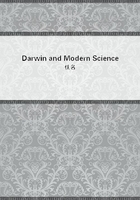
第223章
Darwin had noticed that the flowers of Catasetum do not secrete nectar, and he conjectured that in place of it the insects gnaw a tissue in the cavity of the labellum which has a "slightly sweet, pleasant and nutritious taste." This conjecture as well as other conclusions drawn by Darwin from Catasetum have been confirmed by Cruger--assuredly the best proof of the acumen with which the wonderful floral structure of this "most remarkable of the Orchids" was interpretated far from its native habitat.
As is shown by what we have said about Catasetum, other problems in addition to those concerned with fertilisation are dealt with in the Orchid book. This is especially the case in regard to flower morphology. The scope of flower morphology cannot be more clearly and better expressed than by these words: "He will see how curiously a flower may be moulded out of many separate organs--how perfect the cohesion of primordially distinct parts may become,--how organs may be used for purposes widely different from their proper function,--how other organs may be entirely suppressed, or leave mere useless emblems of their former existence." ("Fertilisation of Orchids", page 289.)In attempting, from this point of view, to refer the floral structure of orchids to their original form, Darwin employed a much more thorough method than that of Robert Brown and others. The result of this was the production of a considerable literature, especially in France, along the lines suggested by Darwin's work. This is the so-called anatomical method, which seeks to draw conclusions as to the morphology of the flower from the course of the vascular bundles in the several parts. (He wrote in one of his letters, "...the destiny of the whole human race is as nothing to the course of vessels of orchids" ("More Letters", Vol. II. page 275.)Although the interpretation of the orchid flower given by Darwin has not proved satisfactory in one particular point--the composition of the labellum--the general results have received universal assent, namely "that all Orchids owe what they have in common to descent from some monocotyledonous plant, which, like so many other plants of the same division, possessed fifteen organs arranged alternately three within three in five whorls." ("Fertilisation of Orchids" (1st edition), page 307.)The alterations which their original form has undergone have persisted so far as they were found to be of use.
We see also that the remarkable adaptations of which we have given some examples are directed towards cross-fertilisation. In only a few of the orchids investigated by Darwin--other similar cases have since been described--was self-fertilisation found to occur regularly or usually. The former is the case in the Bee Ophrys (Ophrys apifera), the mechanism of which greatly surprised Darwin. He once remarked to a friend that one of the things that made him wish to live a few thousand years was his desire to see the extinction of the Bee Ophrys, an end to which he believed its self-fertilising habit was leading. ("Life and Letters", Vol. III. page 276 (footnote).) But, he wrote, "the safest conclusion, as it seems to me, is, that under certain unknown circumstances, and perhaps at very long intervals of time, one individual of the Bee Ophrys is crossed by another."("Fertilisation of Orchids" page 71.)
If, on the one hand, we remember how much more sure self-fertilisation would be than cross-fertilisation, and, on the other hand, if we call to mind the numerous contrivances for cross-fertilisation, the conclusion is naturally reached that "it is an astonishing fact that self-fertilisation should not have been an habitual occurrence. It apparently demonstrates to us that there must be something injurious in the process. Nature thus tells us, in the most emphatic manner, that she abhors perpetual self-fertilisation...For may we not further infer as probable, in accordance with the belief of the vast majority of the breeders of our domestic productions, that marriage between near relations is likewise in some way injurious, that some unknown great good is derived from the union of individuals which have been kept distinct for many generations?" (Ibid., page 359.)This view was supported by observations on plants of other families, e.g.
Papilionaceae; it could, however, in the absence of experimental proof, be regarded only as a "working hypothesis."All adaptations to cross-pollination might also be of use simply because they made pollination possible when for any reason self-pollination had become difficult or impossible. Cross-pollination would, therefore, be of use, not as such, but merely as a means of pollination in general; it would to some extent serve as a remedy for a method unsuitable in itself, such as a modification standing in the way of self-pollination, and on the other hand as a means of increasing the chance of pollination in the case of flowers in which self-pollination was possible, but which might, in accidental circumstances, be prevented. It was, therefore, very important to obtain experimental proof of the conclusion to which Darwin was led by the belief of the majority of breeders and by the evidence of the widespread occurrence of cross-pollination and of the remarkable adaptations thereto.
This was supplied by the researches which are described in the two other works named above. The researches on which the conclusions rest had, in part at least, been previously published in separate papers: this is the case as regards the heterostyled plants. The discoveries which Darwin made in the course of his investigations of these plants belong to the most brilliant in biological science.